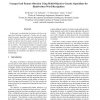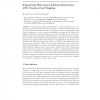IJCNN
2000
IEEE
14 years 11 months ago
2000
IEEE
This paper presents an unsupervised segmentation method for feature sequences based on competitivelearning hidden Markov models. Models associated with the nodes of the Self-Organ...
EUROCOLT
1999
Springer
14 years 11 months ago
1999
Springer
Many settings of unsupervised learning can be viewed as quantization problems — the minimization of the expected quantization error subject to some restrictions. This allows the ...
NLPRS
2001
Springer
14 years 12 months ago
2001
Springer
We describe a new tagging model where the states of a hidden Markov model (HMM) estimated by unsupervised learning are incorporated as the features in a maximum entropy model. Our...
ICDAR
2003
IEEE
15 years 21 days ago
2003
IEEE
In this paper a methodology for feature selection in unsupervised learning is proposed. It makes use of a multiobjective genetic algorithm where the minimization of the number of ...
SSPR
2004
Springer
15 years 23 days ago
2004
Springer
We present a tutorial survey on some recent approaches to unsupervised machine learning in the context of statistical pattern recognition. In statistical PR, there are two classica...
SSPR
2004
Springer
15 years 23 days ago
2004
Springer
Most machine learning algorithms are designed either for supervised or for unsupervised learning, notably classification and clustering. Practical problems in bioinformatics and i...
SAC
2005
ACM
15 years 29 days ago
2005
ACM
Because of name variations, an author may have multiple names and multiple authors may share the same name. Such name ambiguity affects the performance of document retrieval, web ...
JCDL
2005
ACM
15 years 29 days ago
2005
ACM
An author may have multiple names and multiple authors may share the same name simply due to name abbreviations, identical names, or name misspellings in publications or bibliogra...
ICRA
2005
IEEE
15 years 1 months ago
2005
IEEE
Domestic and real world robotics requires continuous learning of new skills and behaviors to interact with humans. Auto-supervised learning, a compromise between supervised and co...
GFKL
2007
Springer
15 years 1 months ago
2007
Springer
Abstract. The manual acquisition and modeling of tourist information as e.g. addresses of points of interest is time and, therefore, cost intensive. Furthermore, the encoded inform...


